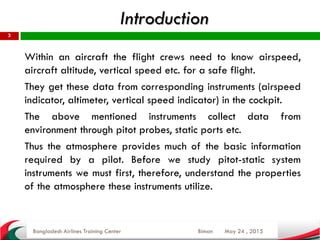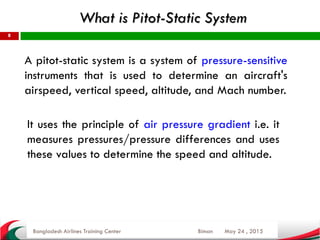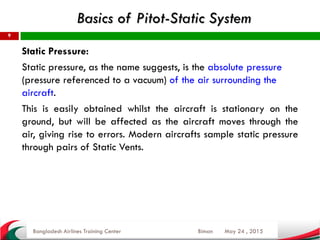Pitot static system
- 1. May 24 , 2015 1 Pitot-Static System Prepared and to be presented by MD. ATAUL MAMUN Bangladesh Airlines Training Center Biman
- 2. Objectives May 24 , 2015 2 Topic Objectives: To have idea on earth atmosphere and its impact on instruments To learn what is pitot-static system To learn basic working principles of instruments that use pitot-static system To understand the limitations of the system Bangladesh Airlines Training Center Biman
- 3. Introduction May 24 , 2015 3 Within an aircraft the flight crews need to know airspeed, aircraft altitude, vertical speed etc. for a safe flight. They get these data from corresponding instruments (airspeed indicator, altimeter, vertical speed indicator) in the cockpit. The above mentioned instruments collect data from environment through pitot probes, static ports etc. Thus the atmosphere provides much of the basic information required by a pilot. Before we study pitot-static system instruments we must first, therefore, understand the properties of the atmosphere these instruments utilize. Bangladesh Airlines Training Center Biman
- 4. Atmospheric Physics May 24 , 2015 4 The earth’s atmosphere is the surrounding envelope of air (mostly Nitrogen, 78.09% and Oxygen, 20.95% gas). The envelope is divided into several layers extending from the earth’s surface. The lowest layer is the troposphere, extending to a height of about 28,000ft (11km) at the equator. This is the start of the tropopause, which goes on up to about 66,000 ft (20km). Above this is the stratosphere, extending to the stratopause at an average height of between 60 and 70 miles. As all aircraft fly in the troposphere or lower levels of the stratosphere we will not concern ourselves with other higher layers. Bangladesh Airlines Training Center Biman
- 5. May 24 , 2015 5 Atmospheric Pressure: The atmosphere is held in contact with the earth's surface by gravity, producing a pressure within the atmosphere. Gravitational effects decrease with increasing distance from the earth's center, so that atmospheric pressure decreases steadily with altitude. The standard sea-level pressure is 14.7 lb/𝑖𝑛2 and is equal to 29.92 in Hg or 1013.25 mbar. The rate at which the pressure falls with height is termed as ‘the lapse rate’. The pressure lapse rate is not linear, but exponential. Bangladesh Airlines Training Center Biman Atmospheric Physics cntd. Standard Pressure Lapse Rate: 1 in Hg per 1000ft. of altitude.
- 6. May 24 , 2015 6 Atmospheric temperature: The air in contact with the earth is heated by conduction and radiation, and as a result its density decreases and the air starts rising. As it rises its pressure falls, allowing the air to expand, the expansion in turn causing a fall in temperature. The air temperature decreases by 1.98°C for every 1,000 feet increase in altitude from +15°C at MSL to -56.5°C at 36,089 feet (i.e. up to tropopause) In the stratosphere the temperature at first remains constant at -56.5°C, then it increases again to a maximum at a height of about 40 miles Bangladesh Airlines Training Center Biman Atmospheric Physics cntd.
- 7. May 24 , 2015 7 Bangladesh Airlines Training Center Biman Figure: ICAO standard atmosphere Atmospheric Physics cntd.
- 8. What is Pitot-Static System May 24 , 2015Bangladesh Airlines Training Center Biman 8 A pitot-static system is a system of pressure-sensitive instruments that is used to determine an aircraft's airspeed, vertical speed, altitude, and Mach number. It uses the principle of air pressure gradient i.e. it measures pressures/pressure differences and uses these values to determine the speed and altitude.
- 9. May 24 , 2015 9 Static Pressure: Static pressure, as the name suggests, is the absolute pressure (pressure referenced to a vacuum) of the air surrounding the aircraft. This is easily obtained whilst the aircraft is stationary on the ground, but will be affected as the aircraft moves through the air, giving rise to errors. Modern aircrafts sample static pressure through pairs of Static Vents. Bangladesh Airlines Training Center Biman Basics of Pitot-Static System
- 10. May 24 , 2015 10 Pitot Pressure: The pitot pressure is a measure of ram air pressure (the total air pressure created by aircraft motion) To understand this, let us consider a probe placed in a flowing fluid. When the fluid flows at a certain velocity, v over the probe, it will be brought to rest at the nose known as the stagnation point. The stagnation pressure of the fluid, also known as the total pressure or the pitot pressure. Bangladesh Airlines Training Center Biman Basics of Pitot-Static System cntd.
- 11. May 24 , 2015 11 Bangladesh Airlines Training Center Biman At the stagnation point, kinetic energy of the fluid is converted into pressure energy. Kinetic energy=pressure energy 1 2 m 𝑣2 = 𝑃𝑉 » 1 2 ρ 𝑣2 = 𝑃 » 𝑣α 𝑃 So, by measuring dynamic pressure we can determine the fluid velocity. (P=dynamic pressure=difference between pitot and static pressure) Basics of Pitot-Static System cntd.
- 12. May 24 , 2015 12 Bangladesh Airlines Training Center Biman Figure: Measuring airspeed by using pitot and static pressures Basics of Pitot-Static System cntd.
- 13. May 24 , 2015 13 Bangladesh Airlines Training Center Biman Air Speed Indicator
- 14. Airspeed indicator measures the difference between the pitot and static pressures in terms of the 1/2ρV2 formula i.e. it measures a differential pressure which varies with the square of the airspeed. Air Speed Indicator cntd. May 24 , 2015 14 Bangladesh Airlines Training Center Biman
- 15. May 24 , 2015 15 Pointer movement means capsule deflection. At low speeds small pointer deflection means large speed variations and vice versa. So direct magnification of deflection would give a non-linear scale reading which is inconvenient to read. To make the dial linear an arrangement needed so that the pointer movement is increased for small deflections and decreased for large deflections i.e. a variable magnification which is called, in this case, the square-law-compensation Bangladesh Airlines Training Center Biman Air Speed Indicator cntd.
- 16. May 24 , 2015 16 Bangladesh Airlines Training Center Biman Figure: Square-law-compensation by rocking lever/sector-arm mechanism Square-law-compensation Air Speed Indicator cntd.
- 17. Vertical Speed Indicator May 24 , 2015 17 VSI is a very sensitive differential pressure gauge, designed to indicate the rate of altitude change from the change of static pressure alone. This indicator consists basically of three main components, I. a capsule, II. an indicating element and III. a metering unit with an orifice/ calibrated leak The orifice is opened to the interior of the case to apply static pressure to the exterior of the capsule. It has a time-lag response characteristic. Bangladesh Airlines Training Center Biman
- 18. May 24 , 2015 18 Bangladesh Airlines Training Center Biman Level flight: zero differential pressure across capsule aircraft descending: metering unit maintains case pressure lower than capsule pressure aircraft ascending: metering unit maintains case pressure higher than capsule pressure Vertical Speed Indicator cntd.
- 19. Altimeter May 24 , 2015 19 Bangladesh Airlines Training Center Biman Figure: Aneroid Barometric altimeter An altimeter operates on the aneroid barometer principle, i.e. it responds to changes in atmospheric pressure. The Altimeter has a sealed evacuated capsule inside a sealed case.
- 20. Altimeter cntd. May 24 , 2015 20 The air pressure on the outside of the capsule tends to squash it, this being opposed by the leaf spring and the spring action of the corrugated metal itself. As barometric pressure increases or decreases, the capsule will be compressed or expanded respectively. By the use of an amplifying lever and chain linkage the expansion and contraction of the capsule is transmitted to a pointer that moves over a scale, calibrated to show barometric pressure, with the leaf and tensioning springs maintaining tension in the linkage. Bangladesh Airlines Training Center Biman The aneroid comes from the Greek aneros, 'not wet‘.
- 21. Altimeter errors due to changes in atmospheric pressure May 24 , 2015 21 The basis for the calibration of altimeters is the standard atmosphere. If the atmospheric pressure at MSL is not standard, the altimeter will be in error. If an aircraft were on the ground on an airfield at sea level with standard pressure (1013.25 mb, 29.92 in Hg) the altimeter would indicate zero feet. If the atmospheric pressure now falls to say, 1012.2 mb (29.89 in Hg) the altimeter would indicate +30 feet. If atmospheric pressure had risen to 1014.2 mb (29.95 in Hg) it would have indicated -30 feet. Similar errors would occur in flight. There is a Baro correction knob to set the pressure of the day in millibars, (or inches of Hg), so that the altimeter displays the correct height. Bangladesh Airlines Training Center Biman
- 22. May 24 , 2015 22 Bangladesh Airlines Training Center Biman Altimeter errors due to changes in atmospheric temperature cntd. The standard atmosphere assumes certain temperature values at all altitudes and consequently non-standard values can also cause errors in altimeter readings. Figure: Effect of atmospheric temperature on an altimeter
- 23. Altimeter Dial May 24 , 2015 23 Bangladesh Airlines Training Center Biman Altimeters used to have three pointers rotating at different rates, one revolution of a pointer indicating one thousand, ten thousand and one hundred thousand feet of altitude respectively.
- 24. ‘Q’ Code for altimeter setting May 24 , 2015 24 It is essential for maintaining adequate separation between aircraft and for terrain clearance during take-off and landing. Meteorological data is transmitted from ATC, forming part of the ICAO “Q" code of communication. The three code groups used in connection with altimeter setting procedures are QNH, QFE and QNE. QFE Setting the pressure prevailing at an airfield to make the altimeter read zero on landing and take-off. QNE Setting the standard sea-level pressure of 1,013.25 mbar (29.92 in Hg) to make the altimeter read the airfield elevation. QNH Setting the pressure scale to make the altimeter read airfield height above sea-level on landing and take-off Bangladesh Airlines Training Center Biman
- 25. May 24 , 2015 25 Mechanical or conventional altimeters suffer from friction in their bearings and mechanical linkages; this leads to the indication lagging actual altitude by as much as 10% (called ‘hysteresis’). As the aircraft climbs hysteresis error increases. These limitations can be overcome by replacing the mechanical linkage between the capsules and pointer with an electrical servo mechanism. In servo altimeter a two-phase drag-cup type motor is coupled by a gear train to the pointer and counter assembly, and also to a differential gear which drives a cam. The reference phase of the motor is supplied with a constant ac voltage from the main source, and the control phase is connected to the amplifier output channel. Bangladesh Airlines Training Center Biman Servo Altimeter
- 26. May 24 , 2015 26 Bangladesh Airlines Training Center Biman Servo Altimeter cntd.
- 27. May 24 , 2015 27 When the aircraft altitude changes the capsule respond that and the displacement of the capsules in transmitted to the I-bar, changing its angular position w.r.t. the E-bar. The ‘E and I Bar’ converts capsule movement into an electrical signal; amplitude being proportional to the amount and phase the direction of that movement. This signal is amplified and fed to a servomotor to drive the pointer and height counters in the correct direction. It also, via the worm gear, cam and cam follower, drives the E bar back to a null position. Indication is similar to the mechanical altimeter. The ‘set ground pressure’ knob puts a bias on the E bar, which is then driven to a null by the servo as before, with the bias appearing as a change of indicated altitude. Bangladesh Airlines Training Center Biman Servo Altimeter cntd.
- 28. Typical pitot probes, static ports and their locations May 24 , 2015 28 A pitot probe consists of a pipe facing into the airflow, with electrical heating to prevent icing and a water drain at its lowest point. The static vents are cross connected, by pipework, in pairs to balance out any pressure difference caused by sideslip of the aircraft. Bangladesh Airlines Training Center Biman
- 29. May 24 , 2015 29 If failure of the primary pitot-static pressure source occurs, for example, complete icing up of a probe due to a failed heater circuit, then it is obvious that errors will be introduced in the indications of the instruments As a safeguard against failure, therefore, a standby system may be installed in aircraft employing pitot-static probes whereby static atmospheric pressure and/or pitot pressure from alternate sources can be selected and connected into the primary system. The required pressure is selected by means of selector valves connected between the appropriate pressure sources and the flight instruments, and located in the cockpit within easy reach of the flight crew. Bangladesh Airlines Training Center Biman Alternate Pressure Sources
- 30. May 24 , 2015 30 Bangladesh Airlines Training Center Biman Alternate Pressure Sources Figure: Alternate pitot pressure and static pressure system
- 31. Pitot-Static Heating May 24 , 2015 31 To prevent icing, the pitot tubes and static ports have an arrangement of heating (usually electrical heating.) The heating elements require 28V DC or 115V AC. The heating circuit has a control switch as well as an indication light to know whether or not the circuit is functioning correctly. In the circuit shown, K1 and K2 are current sensing relays. If the Pilot has failed to switch the heating on; or a heater element has gone open circuit; no current will flow through the relay coil. The relay will de-energise, connecting 28 VDC from the left essential bus to the Master Caution Logic; thus illuminating the appropriate Pitot Heat Caution lamp. Bangladesh Airlines Training Center Biman (The loss of A330 flight AF 447 in mid-Atlantic, June 2009 was due to icing of the pitot probes. )
- 32. Pitot-Static Heating Circuit May 24 , 2015 32 Bangladesh Airlines Training Center Biman
- 33. May 24 , 2015 33 In order for a pitot-static system to operate effectively under all flight conditions, provision must also be made for the elimination of water that may enter the system as a result of condensation, rain, snow, etc., thus reducing the probability of `slugs' of water blocking the lines. Such provision takes the form of drain holes in probes, drain traps and drain valves in the system pipelines. Drain holes are drilled in probe pitot tubes and casings, and are of such a diameter that they do not introduce errors in instrument indications. Bangladesh Airlines Training Center Biman Drains
- 34. Pipelines May 24 , 2015 34 Pitot and static pressures are transmitted through seamless and corrosion-resistant metal pipelines. The diameter of pipelines is related to the distance from the pressure source to the instruments to eliminate pressure drop and time -lag factors. It is very important to ensure that there are no leaks in the pipework, as this would give rise to inaccurate readings. Even though they don't have to handle high pressures, the instruments are very sensitive to small changes in pressure so that even very small leaks can cause errors in the instruments. The tubing and hoses that are used are not very strong and should be inspected carefully for damage. The fittings and connections should be installed with care and torqued to specified values as stated in the AMM. Bangladesh Airlines Training Center Biman
- 35. Pressure (Position) Error May 24 , 2015 35 Measuring airspeed and altitude by pitot and/or static port has two challenges: 1. to design a probe which will not cause any disturbance to the airflow over it 2. To find a suitable location on the aircraft where the probe will not be affected by the disturbance due to aircraft movement itself. A pressure error is introduced in the instrument due to this problem. Pressure or position error (PE) is defined as the difference between the local static pressure and the free-stream static pressure. Altimeter and airspeed indicators suffer from PE most. By using pressuring error correction transducers, we can minimize the pressure or position error. Bangladesh Airlines Training Center Biman


































